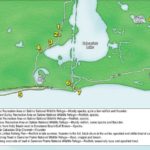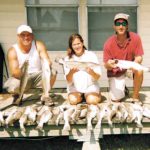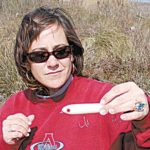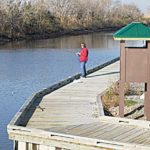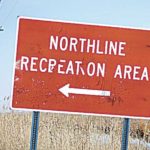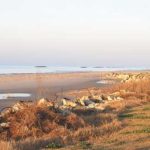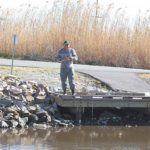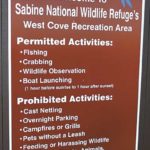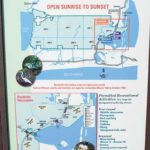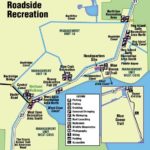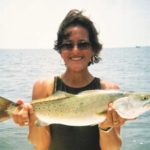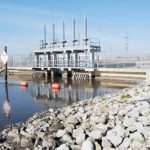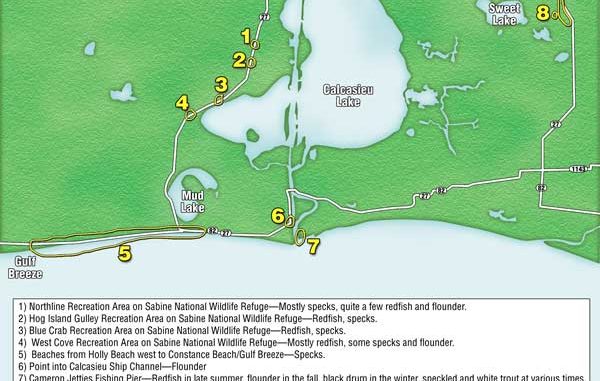
Leave your boat at home, and fish by foot at this incredibly productive Louisiana jewel.
If you look up “spunk” in the dictionary, you might find Keitha Broussard’s picture illustrating the entry.
“I don’t need a man to take me fishing,” she informed me within two minutes after we met.
She had just adjourned a meeting of the Acadia Parish-based Cajun Chapter of the Coastal Conservation Association.
She is the chapter president.
But I found out she isn’t an aggressive fem-libber either. Everything — I mean everything — she owns (except her fishing rods) is pink. She is all-girl. At 5-3, with an olive complexion, dark hair and warm, brown sparkling eyes, she is bouncy, assertive and passionate. But she is still all-girl.
Intrigued, I asked her to show me how she fishes for speckled trout in Southwest Louisiana. She agreed, but modestly added, “I don’t know why anyone would be interested in how I fish. I like to fish like common people do.”
Catching my puzzled look, she explained that even though she, along with her two brothers, has complete use of the 21-foot bay boat that they inherited from their father, she loves to fish for speckled trout from Cameron Parish’s banks and beaches.
“You can just tear them up,” she said.
While heading west on I-10 from Crowley to Sulphur, she explained that her father and grandfather taught her to fish. Much of her early fishing as a small child was done in a freshwater impoundment on the Ponderosa, the family compound east of Esterwood, where she now lives.
The 39-year old fell in love with saltwater fishing about 10 years ago.
“Now I’m addicted to golf, fishing and hunting — cooking too,” she said. “But I can’t cook crustaceans. I’m so allergic to them that I can’t even bait my hook with shrimp without putting on rubber gloves.”
In Sulphur, Broussard turned south on Highway 27 toward the tiny fishing community of Hackberry and beyond.
“I fish for food, not for trophies,” she said. “My kids go ballistic over fried trout. There’s nothing better than the trout you catch fresh as can be. You can’t buy that flavor.
“I prefer to eat about a 2-pound trout. It makes a nice portion of meat. Maybe I don’t have the patience to clean smaller trout. I don’t think that CCA is about catching trophies either; it’s about conservation.”
Soon after Highway 27 entered Sabine National Wildlife Refuge, Broussard pulled off into what refuge signs identified as Northline Recreation Area, and what she and her friends call “The Whirlpool.”
A bridge over the big roadside canal on the west side of the highway provides access to off-road parking and the large and spacious fishing pier set along Northline Canal leading away from the highway. This spot, she identified as her favorite of the four Sabine National Wildlife Refuge Recreation Areas that allow fishing.
Back on the road, and south was the Hog Island Gully Recreation Area. It too is located on a canal from the marsh, this one on the east side of the highway and leading to the northern end of Calcasieu Lake’s West Cove. Broussard said that at times competition from recreational crabbers can make fishing difficult at this spot.
“They are noisy,” she said. “Fish don’t stay where people are throwing nets in the water.”
Heading south again, she passed the refuge’s headquarters and the Blue Goose Trail, neither of which allow fishing. After she crossed over the Little Gras Marais Bridge, the Blue Crab Recreation Area popped up on the west side of the road. True to its name, Broussard says that this fishing area receives heavy pressure from crabbers.
The last of the four fishing areas on the refuge was the West Cove Recreation Area. It was large, sprawling on both sides of Highway 27, although fishing is allowed only on the east side of the road. Large fishing piers extend along both sides of the canal leading to the legendary speckled trout mecca of West Cove.
Broussard explained that her tactics in fishing the four areas are simple. During anything but the coldest months, she will start and stop fishing with topwater lures. She especially loves fishing with Top Dogs and Top Pups, and naturally, one of her favorite colors is pink. But her all-time favorite lure, she said, is a ghost-colored Super Spook.
During January and February, when she takes a break from deer hunting and golfing to fish, she explained that she will resort to using plastic lures and occasionally even shrimp.
“When it is real cold, the big fat sows will be laying on the bottom,” she volunteered.
Back on the road, Broussard headed south on Highway 27 to its juncture with Highway 82 at Holly Beach.
This town is still struggling to pull itself back to life after being hammered by three major hurricanes in four years.
A few, mostly upscale camps tower on ridiculously tall pilings over the sand beneath them, but most lots are empty. So thoroughly did the storms scour the community that even most of the old camps’ pilings seem to be missing.
Broussard pulled her SUV up to an empty lot and stopped.
She talked about the loss of her family’s Holly Beach camps with a sense of mourning.
“Our family had eight camps here,” she said. “Everything was flattened, like someone took his hand and schoop.”
She made a wiping motion with her hand.
“Now with the new regulations, you have to have money to come back,” she said. “Camps have to be 16 feet in the air. It’s not the same Holly Beach. It was so laid back — so laissez-faire. On Sundays, we would go fish til 9:30 a.m., then clean up as best as we could and go to church.”
Although the camps of Holly Beach were destroyed, the fishing stayed good.
“I love to fish on north or northeast winds,” she said. “By 30 hours after a front, you can limit out just like that.”
She snapped her fingers.
“The big thing here isn’t looking for clear water,” she explained. “If you can get it greenish-brackish looking, that is enough to fish in the surf. With a southwest wind, the surf is rough and yucky. And even with a southeast wind, it will get muddy after a while.
From near Holly Beach westward to Constance Beach and Gulf Breeze, segmented rock breakwaters are set offshore of the beach. This is Broussard’s favorite stretch to fish. Some notable spots are just in front of the Mecom Apache Camp and where Highway 82 makes a light turn to the right just before Constance Beach.
She offered tips for fishing the stretch of surf.
“I like to be out there 30 minutes before sunrise,” she said. “Falling tides are better, but the most important thing is to have water movement — the more the better for surf fishing.
“I start shallow early in the morning. Sometimes I don’t even get my feet wet. Then as the sun comes up, I’ll watch as the small baitfish and shrimp move deeper, and I will too.”
By an hour to an hour and a half after sunrise, Broussard said, looking for feeding slicks is one key to good fishing.
“If you have a slick, you have bigger fish feeding on smaller fish,” she said. “Don’t fish in the slick; fish either side of it. I’ll fish a while, and then I’ll watch a while.”
Besides her ghost Super Spook, Broussard’s favorite topwater lures are Top Dogs and Top Pups in pink, black/chartreuse and what she calls LSU colors, purple on top, a silver line down the side and yellow below. She changes lures frequently until she finds the color that seems to work best.
When fishing near the rock breakwaters set off the beach, she will occasionally switch to soft-plastic lures. Her favorites here are purple and salt-and-pepper, both with chartreuse tails.
Very little human development is to be found from Holly Beach to Constance Beach, but it is positively metropolitan compared to the stretch from Holly Beach east toward Cameron. Nothing exists here — just 5 1/2 miles of wide-open, unspoiled beaches interspersed with fish-holding mud flats. Broussard never fishes the stretch, even though she knows it holds fish. She doesn’t need to.
Two miles before the highway hits the Calcasieu Ship Channel, it gradually veers to the left away from the beach and picks up a small but fishable ditch on its northern side.
Continuing to follow combined Highways 27 and 82 to where they met the ship channel and turned north brought Broussard to another favorite spot of hers near the Cameron pogie plant. There, a large shallow flat extended out partway into the channel, providing a favorite spot for her to catch flounder.
After crossing the Cameron Ferry over the ship channel and taking a right turn on Davis Road in the town of Cameron, Broussard hit the next spot on The Common People’s Trail, the Cameron Jetties. Like most jetties, the Cameron Jetties are built of jumbled rocks that are dangerous, or least difficult, to walk on.
But the modern fishing pier is gorgeous and a known hotspot for seasonally strong catches of black drum, redfish and trout. Most famous is its fall run of flounders. Access to the pier costs $10 per person.
The trail then led to territory less explored by Broussard. Ten miles east of Cameron, at the village of Creole, Highway 27 splits from Highway 82 and heads due north.
We followed Highway 27 into the Cameron Prairie National Wildlife Refuge, just north of the Intracoastal Waterway.
There, on a small gravel road that plunged to the west into the refuge, appropriately named Bank Fishing Road, Broussard tried her hand at catching the refuge’s numerous largemouth bass.
According to U.S. Fish & Wildlife Service biologist Rob “Goose” Gosnell, the refuge is indeed a fishing hotspot.
Redfish, he said, very commonly penetrate into the refuge in the huge ditch that parallels the west side of the highway all the way to the refuge headquarters and beyond. During dry years, Gosnell said speckled trout will also be found along the road. And in the refuge’s interior waters, bass, bream and crappie abound.
There, the trail ended. North of the Cameron Prairie National Wildlife Refuge, marshlands ended and farm lands took over the landscape.
On the drive back to her home in Esterwood, Broussard talked about her fishing trail.
“It is good fishing from April into November,” she said. “October might be the best beach fishing month. Anybody with a license, a fishing pole and some Deadly Dudleys, Top Dogs or Top Pups can catch trout, reds and flounder in the places I fish.
“Some people with boats can be arrogant-they want to take over. I can do this with minimal cost. And there is something about fishing on the beach. It’s peaceful.
“I guess that one reason I fish from the bank 99 percent of the time is that I fish with my three kids. I don’t feel comfortable in a boat alone with them.”
